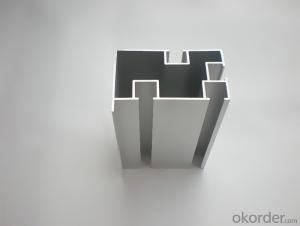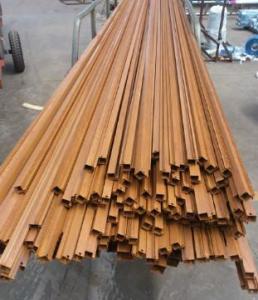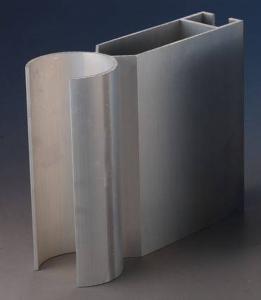Standard Aluminum Extrusion Profiles - Extruded Aluminium Profiles 6063 T6
- Loading Port:
- China Main Port
- Payment Terms:
- TT OR LC
- Min Order Qty:
- -
- Supply Capability:
- -
OKorder Service Pledge
Quality Product, Order Online Tracking, Timely Delivery
OKorder Financial Service
Credit Rating, Credit Services, Credit Purchasing
You Might Also Like
Material | Alloy 6063,6061,6005or according to customer’s choice |
Temper | T3, T4, T5, T6 |
Surface | Anodize, electrophoresis, powder coating, PVDF coating, wood grain painting, matted, etc. |
Color | Any colour based on Standard Germany RAL Mark |
Length | Coating 6.5 meters, Anodizing 6.5 meters, Mill finish 5 meters |






- Q: This question seeks to understand the various types of aluminum profiles that are specifically utilized in the construction of railings and fences.
- <p>Aluminum profiles for railings and fences come in various types, each designed for specific applications and aesthetic preferences. Common types include: 1) Rectangular profiles, which are versatile for both commercial and residential settings; 2) Square profiles, offering a modern look and are often used in minimalist designs; 3) Round profiles, providing a classic appearance suitable for traditional or vintage styles; 4) Slotted profiles, which allow for easy assembly and are popular for their adjustability; 5) Hollow profiles, known for their strength and lightness, ideal for high-load applications; 6) Angled profiles, used to create corners and intersections in railing and fence designs. Each type can be further customized in terms of size, thickness, and finish to meet specific project requirements.</p>
- Q: What are the different surface etching options for aluminum profiles?
- Some different surface etching options for aluminum profiles include chemical etching, mechanical etching, and laser etching. Chemical etching involves using a chemical solution to remove layers of the aluminum surface, creating a desired pattern or texture. Mechanical etching involves using abrasive materials or tools to physically remove material from the surface. Laser etching uses a laser beam to selectively remove material from the surface, creating precise and intricate designs.
- Q: This question asks for an explanation of the various methods employed in the manufacturing of aluminum profiles.
- <p>Aluminum profiles are produced using several manufacturing processes, each suited to different applications and profile shapes. The primary methods include: Casting, where molten aluminum is poured into molds to form profiles; Extrusion, the most common process, where aluminum is pushed through a die to create long, continuous shapes; Rolling, used for creating flat or curved sheets and plates; Forging, which involves shaping aluminum by applying compressive forces; and Machining, where aluminum profiles are cut and shaped using tools. Each process has its advantages and is chosen based on the desired profile's complexity, strength, and cost-effectiveness.</p>
- Q: What are the ten brands of aluminum alloy profiles?
- Latest assessment:1 China Aluminum Group (central management of large state-owned enterprises)The 2 Asia Aluminum Group (Asia's largest aluminum producer, Chinese brand)3 Southwest Aluminum Group (China famous brand)4 Nanshan aluminum (China famous brand, China well-known trademark, national inspection free products)5 silver100 (China brand, Shanghai World Expo aluminum China Museum, Germany Museum special aluminum, A Well-Known Trademark in China)6 South South aluminum (China well-known trademark)7 Zhong Wang aluminum profile (China famous brand, China well-known trademark, national inspection free products)8 (China Jianmei aluminium profile brand, national Mianjian products)9 South Asia Aluminum Profile (China famous brand, national inspection free products)10 aluminum (China linya brand, the old brand, the higher the degree of trust)
- Q: Are there any specific cleaning and maintenance instructions for aluminum profiles?
- Aluminum profiles require specific cleaning and maintenance instructions. Consider the following guidelines: 1. Ensure regular cleaning: To keep the appearance intact and prevent corrosion, it is necessary to clean aluminum profiles regularly. Utilize a mild soap or detergent mixed with water for surface cleaning. Steer clear of abrasive cleaners or steel wool, as they could potentially scratch the aluminum. 2. Steer clear of harsh chemicals: Harsh chemicals have the potential to harm the protective coating of aluminum profiles. Refrain from using strong acids, alkaline cleaners, or solvents for cleaning purposes. 3. Thorough rinsing: After cleaning, ensure that the aluminum profiles are rinsed thoroughly with clean water. This step eliminates any residue from the cleaning solution and prevents streaking. 4. Complete drying: After rinsing, dry the aluminum profiles thoroughly with a soft cloth or towel. Leaving moisture on the surface could result in corrosion, so ensuring the profiles are completely dry is crucial. 5. Lubrication: If the aluminum profiles possess moving parts or hinges, it is advisable to regularly lubricate them to ensure smooth operation. Use a lubricant specifically designed for aluminum to avoid any negative effects. 6. Protective coatings: Some aluminum profiles are equipped with protective coatings, such as anodized or powder-coated finishes. These coatings offer an additional layer of protection against corrosion and should be maintained according to the manufacturer's instructions. 7. Avoid abrasive cleaning tools: When cleaning aluminum profiles, it is important to avoid the use of abrasive cleaning tools such as brushes or scouring pads. These tools can scratch the surface and damage the protective coating. It is important to note that specific cleaning and maintenance instructions may differ based on the type and finish of the aluminum profiles. Thus, it is always advisable to refer to the manufacturer's guidelines for the most effective cleaning and maintenance practices for your specific aluminum profiles.
- Q: Is it possible to recycle aluminum profiles and use them again in construction?
- <p>Yes, aluminum profiles can be recycled and reused in building construction. Aluminum is highly recyclable, and the recycling process requires significantly less energy compared to producing new aluminum. Recycled aluminum maintains its strength and properties, making it suitable for various construction applications. This practice not only conserves resources but also reduces waste and environmental impact.</p>
- Q: Can aluminum profiles be used in corrosive environments?
- Yes, aluminum profiles can be used in corrosive environments. Aluminum has a natural oxide layer that provides excellent resistance to corrosion. Additionally, it can be further protected by various surface treatments like anodizing or powder coating, enhancing its durability and resistance to corrosive elements.
- Q: Can aluminum profiles be used in the production of agricultural machinery?
- Yes, aluminum profiles can be used in the production of agricultural machinery. Aluminum is a lightweight and durable material that can withstand harsh environmental conditions, making it suitable for various components and structures in agricultural machinery. Additionally, aluminum profiles offer flexibility in design and can be easily customized to meet specific requirements, enhancing the efficiency and performance of agricultural equipment.
- Q: Does the profiled bar include aluminum profiles? What are the differences between aluminum and profile?
- In the general title, there are special-shaped material refers to PVC special-shaped material, aluminum refers to aluminum alloy profile
- Q: What are the noise insulation properties of aluminum profiles?
- Compared to other commonly used soundproofing materials like wood or PVC, aluminum profiles demonstrate relatively poor noise insulation properties. Due to its lightweight and thin nature, aluminum allows sound waves to effortlessly penetrate it. Consequently, it fails to offer a substantial obstacle for sound blocking or absorption, resulting in minimal noise reduction. Nevertheless, the noise insulation capabilities of certain aluminum profiles can be enhanced through the inclusion of insulating materials or the utilization of thicker profiles. While these adjustments can somewhat improve the soundproofing performance, they may still not match the effectiveness of materials specifically designed for noise insulation.
Send your message to us
Standard Aluminum Extrusion Profiles - Extruded Aluminium Profiles 6063 T6
- Loading Port:
- China Main Port
- Payment Terms:
- TT OR LC
- Min Order Qty:
- -
- Supply Capability:
- -
OKorder Service Pledge
Quality Product, Order Online Tracking, Timely Delivery
OKorder Financial Service
Credit Rating, Credit Services, Credit Purchasing
Similar products
Hot products
Hot Searches
Related keywords



























